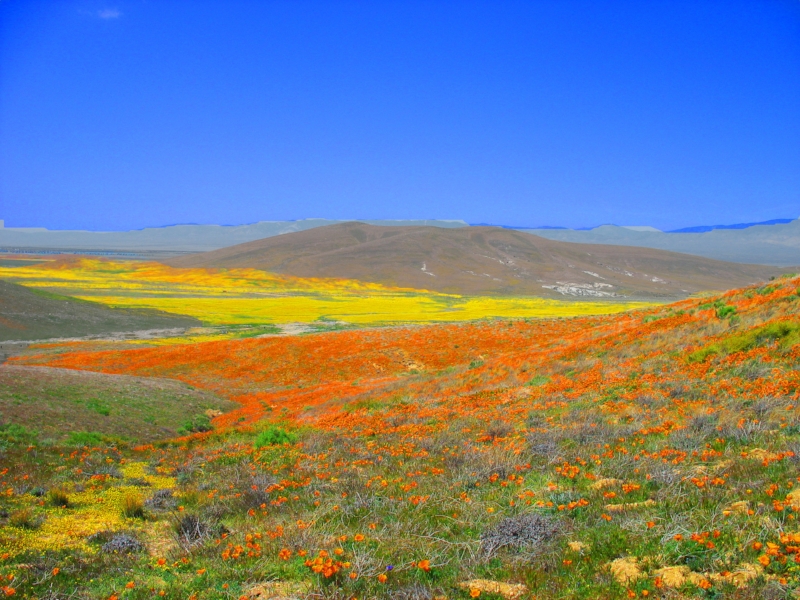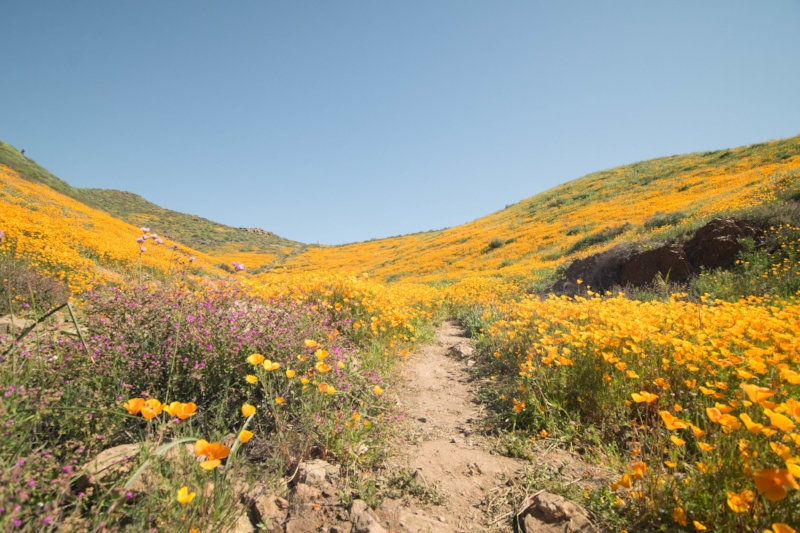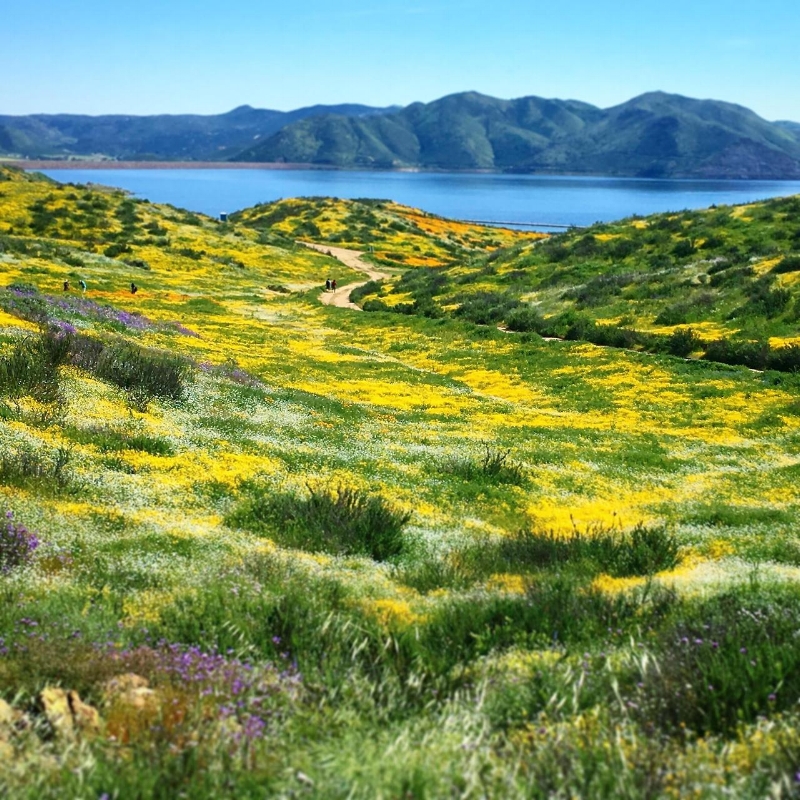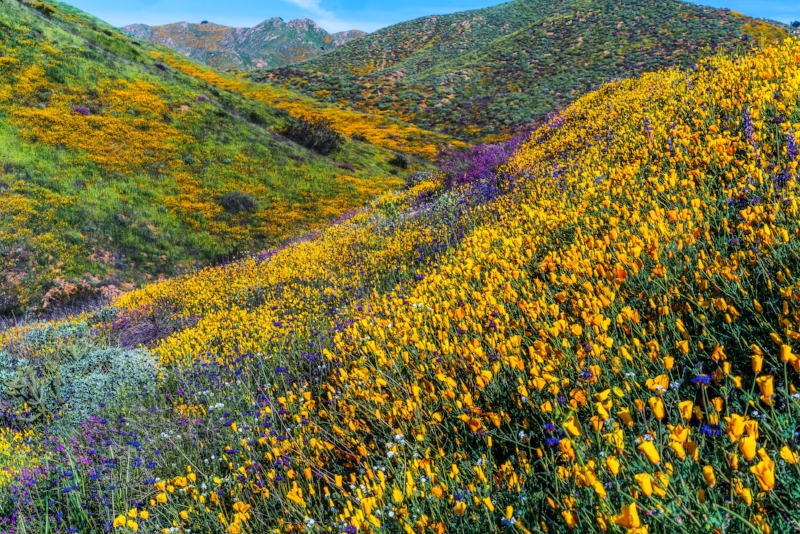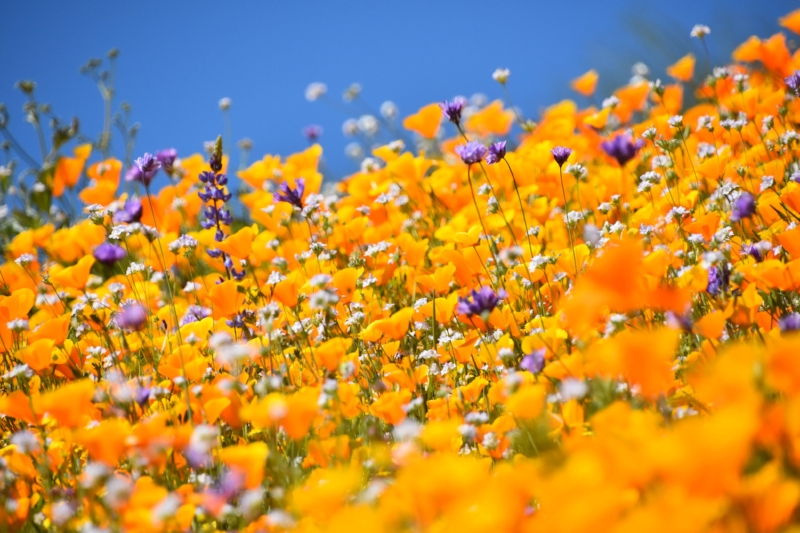California’s wildflower superbloom is so massive, it can be seen from space.
After four years of drought, southern California received a desperately needed ten inches of rain this winter. The dry landscape soaked up this rain, waited, then exploded with color. The Carrizo plain, described as the epi-center of this event, burst with lupine, poppies, fiddleneck, and baby blue eyes. Subtle shifts in topography created clear delineations in color, so painterly, so seemingly designed, that it almost defied credibility. One slope of canary-pineapple-custard-yellow met another field of tangerine-rust-creamsicle-papaya along a seam of indigo-berry-blue. The impact of the superbloom defied scale: one square foot was as stunning in its detail as several square miles.
Of course, the event was so spectacular that it drew a stampede of people coming to photograph it. Mashable had an interesting article about tourists trampling fields of poppies. It’s funny how in a digital age when confronted with an event of great beauty, our first temptation is to pull out our smartphone. Moses, in the presence of the Almighty, shielded his face with a veil; we, in the presence of overwhelming beauty, shield ourselves with our iPhones. I noticed this phenomenon when I visited Chicago’s Lurie Garden—a two-acre perennial garden designed by Piet Oudolf—in its October glory. Everywhere I walked, outstretched arms with tiny rectangles focused and clicked. The current director told me the biggest threat to the garden was not rabbits or voles, but tourists in search of the Echinacea pallida-selfie. Wordsworth wrote odes to daffodils; Cezanne painted canvases; teenagers carved their initials on beech trunks. We now immortalize our experiences on Instagram.
But what does it mean? Nothing and everything. In some ways, extracting meaning from an event of such majesty is like clamping beauty itself under the vice grips—dissecting its organs and placing them into formaldehyde filled jars. Language does not amplify, it shrinks. So part of me says: "leave it alone!" The superbloom merely is, and that is enough, now please shut up and go back to your spreadsheets.
Yet the fact that my mind keeps going back to it, the tingly excitement I feel when I think of it, says it means something to me. To open one’s mind to the mere existence of a superbloom shreds all kinds of narratives: the end of nature, the hopelessness of our times, the loss of wildness. “‘Post-truth’ does not exist in the opening of tree buds,” wrote David George Haskell in a recent editorial in The New York Times. He concludes that attentiveness to the lives of others—insect, flower, mammal, our neighbors—is an act of resistance in itself.
Yes! A resistance. That’s exactly the way I experienced this event. The fact is, I needed this superbloom. Like the dry California landscape, I was thirsty for a reminder that the world still holds so much beauty, thirsty to be reminded by the power of wildness, and the extraordinary resiliency of self-organizing systems. Despite the ravages of globalization and industrialization, despite the multiple extinctions of biodiversity happening at this very second, the fact that nature still has the capacity to overwhelm us with its beauty, fecundity, and majesty is the most singularly hopeful event I can imagine. Let it in.
What does one do next? How does one respond to an experience of glory? I am reminded of Annie Dillard’s famous essay about viewing a total solar eclipse. Dillard went with her husband up a mountain to watch the sun be extinguished for a few moments of sheer other-worldly terror and sublimity. When she came down from the mountain, she went to breakfast and thought:
The mind wants to live forever, or to learn a very good reason why not. The mind wants the world to return its love, or its awareness; the mind wants to know all the world, and all eternity, and God. The mind’s sidekick, however, will settle for two eggs over easy.
The dear, stupid body is as easily satisfied as a spaniel. And, incredibly, the simple spaniel can lure the brawling mind to its dish. It is everlastingly funny that the proud, metaphysically ambitious, clamoring mind will hush if you give it an egg.
So I bid you, dear readers, happy breakfasts! Since I cannot see the superbloom in person, I will happily consume images of it on Instagram while eating my cereal. And I will be grateful for the defiance of annuals.
